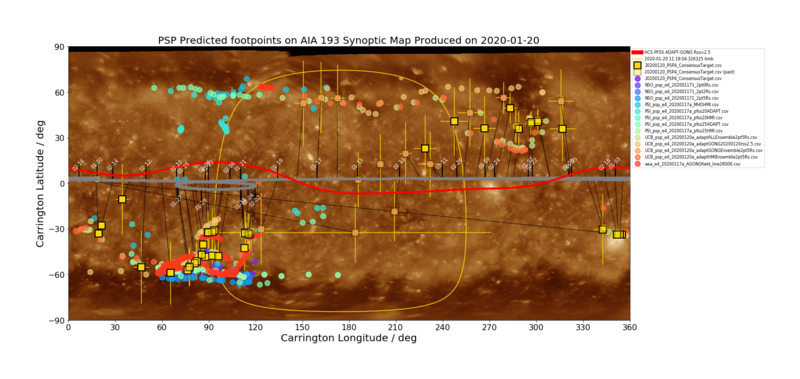A PSP Perihelion
From RHESSI Wiki
(initial bit) |
|||
| Line 47: | Line 47: | ||
solar minimum: it hugs the equator. | solar minimum: it hugs the equator. | ||
]] | ]] | ||
| + | |||
| + | == North or South? == | ||
| + | |||
| + | == Conclusions == | ||
| + | |||
| + | == Bibliography == | ||
Revision as of 15:26, 21 January 2020
| Nugget | |
|---|---|
| Number: | 369 |
| 1st Author: | Jessie Duncan |
| 2nd Author: | Hugh Hudson |
| Published: | 20 January 2020 |
| Next Nugget: | TBD |
| Previous Nugget: | A Global Survey of EUV Coronal Power Spectra |
| List all | |
Contents |
Introduction
The [Parker Solar Probe] is edging its way into the innermost heliosphere, one perihelion at a time. This Nugget deals with planning for these occasions, which may produce the major breakthrough of an actual identification of the magnetic connectivity between a 2D point on the surface of the Sun with a point in the 3D space that the spacecraft traverses. It might be an actual *event*, of the sort long sought for by RHESSI in the form of a match between SEP electrons and flare ejecta. But more likely it will have to do with the [*strahl*] component of the solar wind.
In either case we need to proceed from our existing understanding of the coronal magnetic field (limited) to make a best guess about where to look. This is vitally important for imaging instruments with small fields of view. The imminent perihelion is the first really good one, with the footpoint on the visible hemisphere, but there will be a continuous set of future perihelia with the same issue, as we proceed into Cycle 25.
Identifying the likely footpoint
An expert team has tackled this problem, with a helpful Web site at
https://whpi.hao.ucar.edu/whpi_campaign-cr2226.php
in which one can see updating maps providing target information. The example map at the time of writing this Nugget is here as Figure 1.
North or South?
Conclusions
Bibliography
| RHESSI Nugget Date | 20 January 2020 + |
| RHESSI Nugget First Author | Jessie Duncan + |
| RHESSI Nugget Index | 369 + |
| RHESSI Nugget Second Author | Hugh Hudson + |
